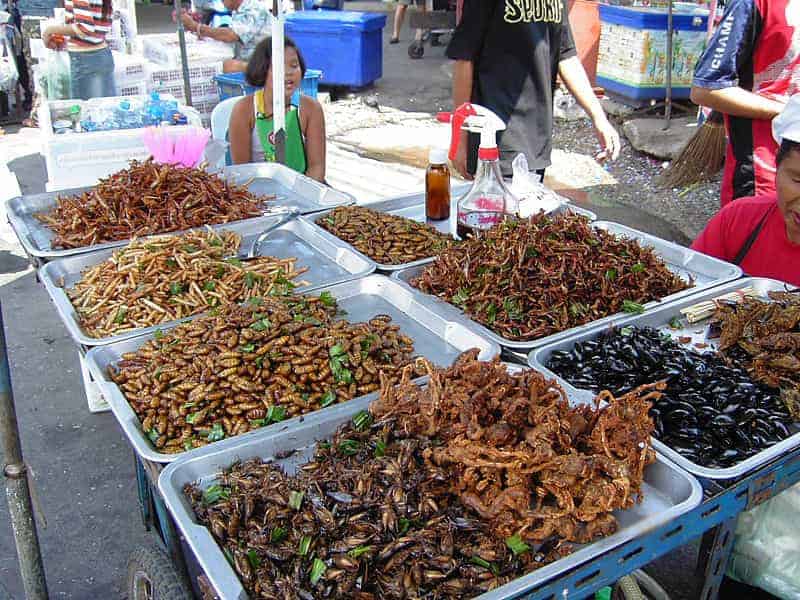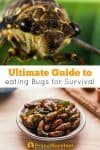A major disaster occurs, and you’ve got to flee with your family to the wilderness. You’ve packed a Bug Out Bag (more on what to pack in your BOB here). But soon, your survival food will run out. What do you plan on eating?
Most survivalists and preppers love to share all sorts of wilderness fishing and hunting hacks, but the reality is that hunting your own food is difficult.
Even if you manage to hunt down a deer, what will you do with all that meat? You would need to hang it to dry, which means attracting animals to your camp… assuming that you will even stay at the same camp while waiting out the disaster.
Save your energy, and don’t bother hunting. The best wilderness survival food is insects.
Bug Eating is Completely Normal…

Think that eating bugs is gross? Then you are going against our nature. Evidence shows that bugs made a big portion of the diet of ancient humans.
Even after humans learned agriculture and hunting, they still loved to eat bugs. The ancient Romans would eat beetle larvae reared on flour and wine. Aristotle wrote about the Greek practice of harvesting cicadas for food. Even the Bible encourages people to eat certain bugs!
Eating insects is still completely normal in many cultures, particularly in Asia and Africa. Yet, in the United States and most other Westernized countries, eating bugs is taboo.
How did we go from chowing down on bugs to thinking they were gross? One theory is that, as people began to invest more in agriculture, bugs began to be seen as pests since they destroyed crops.
The bottom line is that, in a survival situation, you better get over the yuck factor of eating bugs. There is nothing gross about eating bugs. Let me put this in perspective for you. If you eat eggs, you are eating something which came from a chicken’s butt! But you don’t find that gross, do you?
Which Bugs Are Edible?
There are over 1,400 types of edible bugs in North America alone! I doubt you will spend your time memorizing all of these edible bugs and then learning to identify them. So, follow these rules to determine if a bug is edible:
- Pretty much all bugs are edible!
- Avoid bugs that sting
- Avoid hairy bugs
- Avoid bugs with bright colors
- Avoid disease carriers (ticks, mosquitoes, flies…)
There are a lot of exceptions to these rules, though. For example, bees sting but are edible and considered quite tasty. Tarantulas are hairy and are sold roasted as a delicacy in many cultures. Even if a bug has some harmful poison, it can usually be destroyed by cooking.
Top Edible Bugs in North America
These are just some of the many edible bugs found in North America. Remember, almost ALL bugs are edible, so feel free to lift a log and eat whatever you find in a survival situation.
- Crickets
- Grasshoppers
- Caterpillars
- Ants
- Beetles
- Centipedes (but NOT millipedes! Do NOT eat millipedes!)
- Termites
- Insect larvae
- Honeybees
How to Catch Bugs for Food
Bugs are all over the place, which is why they make sure a good survival food. You can lift up an old log and find a tasty snack of some beetles. Or dig in the dirt, and you will surely find some bugs to eat. But if you want a proper meal, you must catch more bugs at once. Here are some methods:
Pitfall Trap
This is used for catching crawling bugs like beetles. It is straightforward to make. You just need some sort of cup to put in the ground and a lid to go over it. A tin can will work well, or cut a plastic bottle.
- Dig a hole the size of your cup
- Put your cup into the hole; the edges of the cup should be level with the ground
- Put some rocks around the outside of the cup. These will hold up your lid.
- Put the lid on top of the rocks. Ideally, the gap should be about ½ to 1 inch.
- Check your pitfall trap every 24 hours and remove any bugs you find.
Tips:
- Put some bait into the trap. A piece of fruit works great for catching crickets and grasshoppers!
- Put a funnel into your cup, and the bugs won’t be able to get out! The top of a plastic bottle works great.
Harvesting Bugs for Food
Once you have a few bugs, you can breed them easily and have a steady food supply. I’d suggest breeding grasshoppers since they reproduce quickly, are nutritious, and are strict herbivores (crickets will go carnivorous if you don’t feed them their favorite foods!!!).
You’ll need some sort of large container to keep them in. For grasshoppers to breed, you must put a bit of sand in the cage. Keep the sand slightly moist, or the eggs won’t hatch.
Always Cook Insects Before Eating Them!

Why do we think eating insects is so gross? Maybe it is because of stupid reality TV shows which show the hosts or contestants eating live or uncooked insects.
Would you eat raw hamburger? No.
So why would you eat raw insects?
Like raw beef can contain bacteria and parasites, so can insects. Cooking them will destroy them, so the insects are safe to eat. Oh, and the insects will taste better when cooked.
Here are some examples of how to cook insects so they are safe to eat and taste better:
- Ants: Roast them
- Slugs: Chop off their heads and squeeze out their entrails (this will get the poop out of their bodies too). Then boil them or roast them.
- Snails: Pull them out of their shells, slit them, and squeeze out the entrails. Then boil or roast them.
- Crickets and grasshoppers: Roast them; you can also make flour of out them. Roast them in the oven until completely dry, and then use a mortar to crush their bodies. Now you have flour!
- Caterpillars: Boil them for 1 minute or roast them
- Termites: Slightly roast them
- Mealworms: Boil for 1 minute or sauté in oil/butter
And Don’t Forget to Take the Wings and Legs Off!
If you’ve ever eaten an entire bug, it probably felt terrible going down your throat. That is because the wings and legs get caught in your throat. You could even choke this way.
Just grab the wings/legs and twist them to take them off. This will greatly improve your insect-eating experience! 🙂
Can you imagine yourself eating bugs in a survival situation? Have you tried bugs? Let us know!



Like all class room knowledge, getting some first hand experience such as using a trap, or preparing bugs, or eating plants. Is nice, but when the situation arises, will you know what to do? Will you be able to actually set a snare for a squirrel or catch some grasshoppers? Or look at a plant growing by the road and know what to do next? I’ve watched many youtube videos on setting snares, but they don’t show you if it really works. Then, can you go out and do the same? I know there are laws as to if it’s in season or not. But in a survival situation, I’m not going to worry about weather it’s in season or not. So trying it a couple of times so you don’t have to make the mistakes while your life may depend on doing it right.
Eat only “fresh” insects? What about insects found already dead?
Definitely don’t eat those ones! Just like you wouldn’t eat a dead animal which had been laying around for who knows how long.
I ate a grasshopper for the first time at high schools – it just had the misfortune of jumping in during class, and I was up to pull a stunt that day. I just ate it whole and alive, wings and legs included. It tasted good, actually, even raw – I know you’re supposed to cook them, but I couldn’t really light a fire in class, could I? It tasted so good I repeated the experience other times while taking a walk in the woods. If I happen to catch one, I’m going to eat it, regardless of time and place.
You can raise them pretty easily and grind them into a powder to add to baked goods. But I’d still say you should cook them first!
I have always wondered whether bugs should be cooked before eating. This is the only site that I have seen recommending it. I have heard other references saying that you don’t have to cook them (even maggots on rotting flesh–which I find hard to swallow–yuck, yuck). I agree with your statements about potential parasites…and I still wonder. The hamburger analogy is a bad one, as that is raw meat that has been sitting around for quite a while. Raw sushi is a better analogy: it can be done, but there is still a potential if it is too old. So what about living insects? Because I have seen nothing (until here) saying you can’t, I have. Specifically, ants, termites, and grubs (only once–that was enough). So I have to wonder: are some insects safer to eat living? Like ants, grasshoppers, and termites?
That’s a good question. I’d bet there are some which are inherently safer than other insects. But I’d still cook all types anyway.
As for raw fish, some types are not recommended to eat raw because they often have parasites. Apparently all sushi fish (in the USA at least) is treated to kill parasites: “Food and Drug Administration regulations stipulate that fish to be eaten raw — whether as sushi, sashimi, seviche, or tartare — must be frozen first, to kill parasites”
Thank you for posting this article.Back in the old west; utah got hit by a locust swarms. So Mormon settlers created recipes for cooking and eating them.
Cool! I just remembered reading about locust swarms in Little House on the Prarie. Shame Laura Engles Wilder didn’t talk about eating them afterwards 🙂
Totally eaten crickets before, they’re sold as a novelty here at the local lake gift shop. They’re crunchy, kinda like a popcorn kernel. Don’t really have a flavor or anything. In a survival situation it wouldn’t be horrible to catch crickets/grasshoppers/ants and roast them up to keep from starving.
One insect I will NEVER eat is a cock roach.
If I ever ate a roach I would vomit my guts out and lose way more than I would gain.
Worms, tadpoles, crickets are all fine.
They are perfectly edible but I agree the concept takes a little getting used to!
I cooked and tried ants yesterday
How were they?
You mentioned not eating millipedes. Are they toxic?
Yes most types of millipedes have toxic chemical defenses – More here.
I catch grasshoppers and put them on stick shish-ka-bob style and roast them over a fire. Once crispy you can dip in honey and eat those sweet crunchy critters all day.
sounds dullish
I agree, I’ve had them pan fried in butter with a little salt. Great around the camp fire with a cold beer.
Heybim a big fan ive never thiught of eating them but was wondering what do they taste like
They taste OK but the texture can be challenging!
If you are stranded without a frying pan on hand, how will you cook them?
Time to use your improvisation skills. They could be boiled in a tin can, roasted on the tip of a twig etc etc.
Kat, saludos. Los podrías cocinar sobre una piedra, encima de la leña encendida, etc., etc.
Little sticks or on a heated rock.
Gal! Our folks went on a bug eating time, bunches of years ago, but I believe everything was covered in chocolate, and they were swilling down lots of beer every time. Hubby and I didn’t join in, besides we had little kids to care for.
Ha Ha beer and chocolate would certainly help in this scenario!
Maybe a little off topic, but relevant since they have similar nervous systems. Scientists have done studies which confirm aversive behavior in crustaceans. Which is to say crabs, lobsters etc have shown avoidance behavior to stimulus that humans would regard as painful. Taking that as given, two things need to be said: 1) Stimulus response varies widely just within the human species, to posit a similar experience of “pain” as we understand it is not only across an entirely different species, but an entirely different CLASS of animal (kingdom, phylum, class, order, family, genus, species) is a HUGE stretch at best. 2) Even if we accept that insects do feel pain as we understand it, it’s important to put things in perspective. The percentage of insects that die from old age is vanishingly small. If I’m eating bugs it’s because I need to, and if I have to pick me or some bugs to continue to exist I’m picking me every time. Lastly, since insects typically have several “sub-brains” at various locations throughout their body there is no practical way to kill an insect quickly, cleanly and mercifully that would leave it fit for consumption, and it’s almost certainly not possible in field expedient conditions. Insect welfare is sort of a microcosm of Survival in general; be merciful if you can, but keep things in perspective and make sure it’s you who survives.
This is all getting very philosophical! I think we can all agree that in a SHTF situation such concerns will soon be forgotten. Interesting subject though.
I am living in Beijing, China. Here they serve silk worms as a totally typical food. If you go down south to Yunnan, you get crispy fried crickets. No yuck reaction from the locals. I would assume our disgust is cultural and probably fueled by ignorance. In my classroom (3-6 y.o.) we keep a stag beetle and crickets to feed fish and frogs. Kids who know how to catch and care for insects have neither fear nor disgust. Learning to breed crickets is a fun project and survival skill all in one.
This is a great article. Thank you for sharing it. I read somewhere that termites offer the least potential for parasites because they are a wood boring bug therefore, they are not exposed to as many parasites. The same principle applies to grubs.
Would u kill them first? Seems mean to cook something alive but how do u kill them without squashing them?
Not something I would worry about in a SHTF situation. Interesting point though – I found a good article on Wiki if you want to investigate further – https://en.wikipedia.org/wiki/Welfare_of_farmed_insects
Hi, I grew up on a dairy farm in NZ in the 70’s-80’s. Every weekend as a kid I used to shoot and trap possoms and rabbits. I would skin and clean them straight away then continue on my hunt. On my way home I would distribute them to
my uncles my grandparents and our neighbours. We would all have stew that same night with wild watercess and anything else growing around the place that was edible. We were by no means in a SHTF situation back then either. They truly were the good old days. Recently when I was working out in the centre of Australia with a Thai friend swarm of grasshoppers swept through the area. My Thai friend got a couple of big bags of them to take back to camp. He emptied the bags into a huge tub of water so they couldn’t fly away. Heated up a pan with a big chunk of butter. Then he pulled the wings and back legs off and threw them straight on the pan. After flipping around for a few minutes until golden brown, a couple of pinches of salt and they were ready to eat. Mmmm mmmm yum.
I think u could pull the head off and wait a few seconds
Mason jar with a lid…pour rubbing alcohol on a cotton swab…place it in the bottom of the jar…put the insect into the jar close the lid